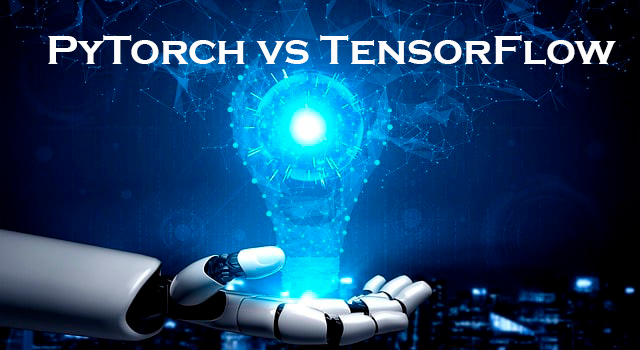PyTorch vs. TensorFlow: Which AI Framework Is Right for You?

In the world of artificial intelligence (AI) and machine learning (ML), choosing the right framework can significantly impact your project’s success. Among the most popular choices are PyTorch and TensorFlow, two robust frameworks that dominate the AI landscape. This article provides an in-depth comparison to help you decide which AI framework suits your needs, whether you’re an academic researcher, industry professional, or AI enthusiast.
Table of Contents
Understanding PyTorch and TensorFlow
What Is PyTorch?
Developed by Facebook’s AI Research (FAIR) lab, PyTorch is an open-source machine learning framework. It is widely appreciated for its dynamic computational graph and ease of use, making it a favorite for research and experimentation.
What Is TensorFlow?
TensorFlow, developed by Google Brain, is another open-source machine learning framework designed for both research and production. Its ecosystem includes tools for building, training, and deploying ML models on various platforms.
While both frameworks serve similar purposes, their approaches and strengths differ, which can influence your decision based on project requirements.
Key Differences Between PyTorch and TensorFlow
1. Computational Graphs
- PyTorch: Uses a dynamic computational graph, meaning the graph is built on-the-fly as operations are performed. This provides flexibility and makes debugging intuitive.
- TensorFlow: Employs a static computational graph by default, requiring the graph to be defined and compiled before execution. However, TensorFlow 2.x introduced eager execution, allowing for more dynamic behavior similar to PyTorch.
Verdict: PyTorch is better for researchers and developers who value flexibility, while TensorFlow excels in production scenarios requiring graph optimization.
2. Ease of Use
- PyTorch: Known for its Pythonic syntax, PyTorch feels natural to Python developers. Its straightforward API simplifies model development and debugging.
- TensorFlow: TensorFlow’s initial versions were criticized for their steep learning curve. However, TensorFlow 2.x addressed many of these issues, introducing Keras as its high-level API for more intuitive model building.
Verdict: PyTorch is more beginner-friendly, but TensorFlow has closed the gap with its updated API.
3. Performance and Deployment
- PyTorch: While excellent for prototyping, PyTorch was initially considered less suitable for production. However, the introduction of TorchScript has improved its deployability.
- TensorFlow: TensorFlow shines in production environments, offering features like TensorFlow Serving, TensorFlow Lite, and TensorFlow.js for deploying models across various platforms, including mobile and web.
Verdict: TensorFlow is the better choice for production and deployment, though PyTorch is catching up.
4. Ecosystem and Tools
- PyTorch: Features like PyTorch Lightning simplify model training workflows. However, its ecosystem is not as extensive as TensorFlow’s.
- TensorFlow: TensorFlow boasts a comprehensive ecosystem, including TensorFlow Hub, TensorFlow Extended (TFX), and TensorBoard for model monitoring and visualization.
Verdict: TensorFlow offers a more mature ecosystem, making it a stronger option for end-to-end machine learning pipelines.
5. Community and Industry Adoption
- PyTorch: Preferred by researchers and academia due to its flexibility and dynamic graphing capabilities. Many cutting-edge research papers are implemented in PyTorch.
- TensorFlow: Widely used in industry and enterprise environments for production-grade applications. It also has strong support for cloud services like Google Cloud AI.
Verdict: Choose PyTorch for research and TensorFlow for industrial applications.
Comparison Table: PyTorch vs. TensorFlow
| Feature | PyTorch | TensorFlow |
|---|---|---|
| Computational Graph | Dynamic | Static (with eager execution) |
| Ease of Use | Beginner-friendly | Improved with TensorFlow 2.x |
| Deployment Tools | TorchScript | TensorFlow Serving, Lite, JS |
| Ecosystem | Developing | Mature and extensive |
| Industry Adoption | Academia and research-focused | Enterprise and production-focused |
Use Cases for PyTorch and TensorFlow
When to Choose PyTorch
- Research and Experimentation: PyTorch’s dynamic graph makes it ideal for innovative research and rapid prototyping.
- NLP and Vision Projects: Widely used in natural language processing (NLP) and computer vision tasks, supported by libraries like Hugging Face Transformers.
- Educational Purposes: Its simplicity and Pythonic nature make it perfect for teaching and learning ML concepts.
When to Choose TensorFlow
- Production-Grade Applications: TensorFlow’s tools for deployment and scalability are unmatched.
- Mobile and IoT Development: TensorFlow Lite enables seamless integration with mobile devices.
- Comprehensive Pipelines: TensorFlow’s ecosystem supports the entire ML workflow, from data preprocessing to model deployment.
Popular Libraries and Frameworks Built on PyTorch and TensorFlow
PyTorch-Based Libraries
- TorchVision: Focused on computer vision applications.
- PyTorch Lightning: Simplifies research workflows with clean code and reproducibility.
- Fairseq: A Facebook-developed library for sequence modeling tasks.
TensorFlow-Based Libraries
- Keras: High-level API for building and training models.
- TensorFlow Hub: A library for reusable ML models.
- TFX (TensorFlow Extended): For end-to-end machine learning pipelines.
Real-World Applications of PyTorch and TensorFlow
PyTorch in Action
- Facebook AI: Uses PyTorch for research in NLP and computer vision.
- Tesla Autopilot: Elements of Tesla’s AI are reportedly built with PyTorch.
TensorFlow in Action
- Google Search and Assistant: TensorFlow powers many Google services.
- Airbnb: Uses TensorFlow for dynamic pricing and search ranking algorithms.
Future of PyTorch and TensorFlow
The rivalry between PyTorch and TensorFlow continues to drive innovation. PyTorch’s growing adoption in industry and TensorFlow’s relentless evolution ensure both frameworks remain relevant.
- PyTorch’s Growth: With its expanding ecosystem and focus on deployability, PyTorch is closing the gap in production-readiness.
- TensorFlow’s Advancements: TensorFlow continues to enhance usability and broaden its deployment options.
Conclusion: Which Framework Is Right for You?
Choosing between PyTorch and TensorFlow depends on your specific needs:
- Choose PyTorch if you prioritize ease of use, flexibility, and cutting-edge research.
- Choose TensorFlow if you require a robust ecosystem, scalability, and production-ready tools.
Ultimately, both frameworks are powerful and versatile, and familiarity with both can be a significant advantage in the rapidly evolving field of AI.
keep reading:
